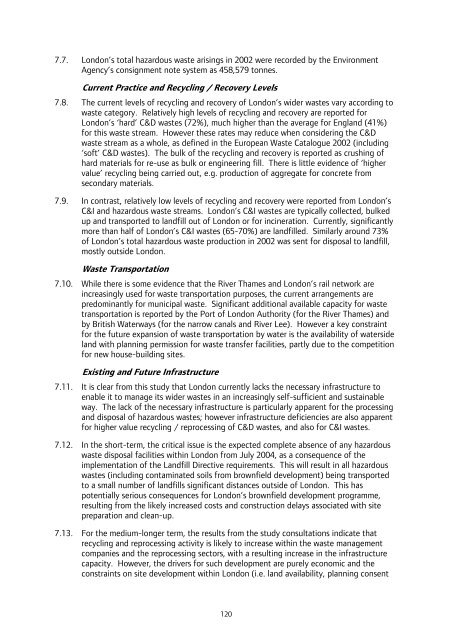London Wider Waste Strategy - London - Greater London Authority
London Wider Waste Strategy - London - Greater London Authority
London Wider Waste Strategy - London - Greater London Authority
Create successful ePaper yourself
Turn your PDF publications into a flip-book with our unique Google optimized e-Paper software.
7.7. <strong>London</strong>’s total hazardous waste arisings in 2002 were recorded by the Environment<br />
Agency’s consignment note system as 458,579 tonnes.<br />
Current Practice and Recycling / Recovery Levels<br />
7.8. The current levels of recycling and recovery of <strong>London</strong>’s wider wastes vary according to<br />
waste category. Relatively high levels of recycling and recovery are reported for<br />
<strong>London</strong>’s ‘hard’ C&D wastes (72%), much higher than the average for England (41%)<br />
for this waste stream. However these rates may reduce when considering the C&D<br />
waste stream as a whole, as defined in the European <strong>Waste</strong> Catalogue 2002 (including<br />
‘soft’ C&D wastes). The bulk of the recycling and recovery is reported as crushing of<br />
hard materials for re-use as bulk or engineering fill. There is little evidence of ‘higher<br />
value’ recycling being carried out, e.g. production of aggregate for concrete from<br />
secondary materials.<br />
7.9. In contrast, relatively low levels of recycling and recovery were reported from <strong>London</strong>’s<br />
C&I and hazardous waste streams. <strong>London</strong>’s C&I wastes are typically collected, bulked<br />
up and transported to landfill out of <strong>London</strong> or for incineration. Currently, significantly<br />
more than half of <strong>London</strong>’s C&I wastes (65-70%) are landfilled. Similarly around 73%<br />
of <strong>London</strong>’s total hazardous waste production in 2002 was sent for disposal to landfill,<br />
mostly outside <strong>London</strong>.<br />
<strong>Waste</strong> Transportation<br />
7.10. While there is some evidence that the River Thames and <strong>London</strong>’s rail network are<br />
increasingly used for waste transportation purposes, the current arrangements are<br />
predominantly for municipal waste. Significant additional available capacity for waste<br />
transportation is reported by the Port of <strong>London</strong> <strong>Authority</strong> (for the River Thames) and<br />
by British Waterways (for the narrow canals and River Lee). However a key constraint<br />
for the future expansion of waste transportation by water is the availability of waterside<br />
land with planning permission for waste transfer facilities, partly due to the competition<br />
for new house-building sites.<br />
Existing and Future Infrastructure<br />
7.11. It is clear from this study that <strong>London</strong> currently lacks the necessary infrastructure to<br />
enable it to manage its wider wastes in an increasingly self-sufficient and sustainable<br />
way. The lack of the necessary infrastructure is particularly apparent for the processing<br />
and disposal of hazardous wastes; however infrastructure deficiencies are also apparent<br />
for higher value recycling / reprocessing of C&D wastes, and also for C&I wastes.<br />
7.12. In the short-term, the critical issue is the expected complete absence of any hazardous<br />
waste disposal facilities within <strong>London</strong> from July 2004, as a consequence of the<br />
implementation of the Landfill Directive requirements. This will result in all hazardous<br />
wastes (including contaminated soils from brownfield development) being transported<br />
to a small number of landfills significant distances outside of <strong>London</strong>. This has<br />
potentially serious consequences for <strong>London</strong>’s brownfield development programme,<br />
resulting from the likely increased costs and construction delays associated with site<br />
preparation and clean-up.<br />
7.13. For the medium-longer term, the results from the study consultations indicate that<br />
recycling and reprocessing activity is likely to increase within the waste management<br />
companies and the reprocessing sectors, with a resulting increase in the infrastructure<br />
capacity. However, the drivers for such development are purely economic and the<br />
constraints on site development within <strong>London</strong> (i.e. land availability, planning consent<br />
120
















